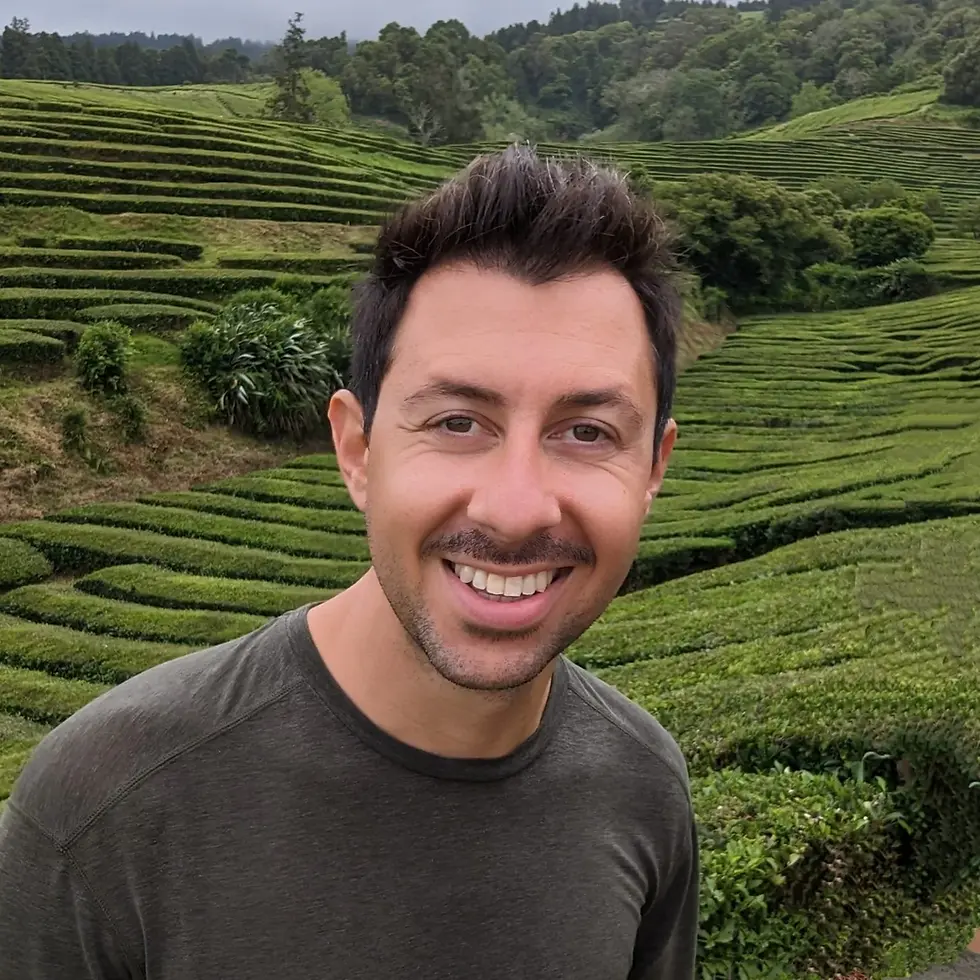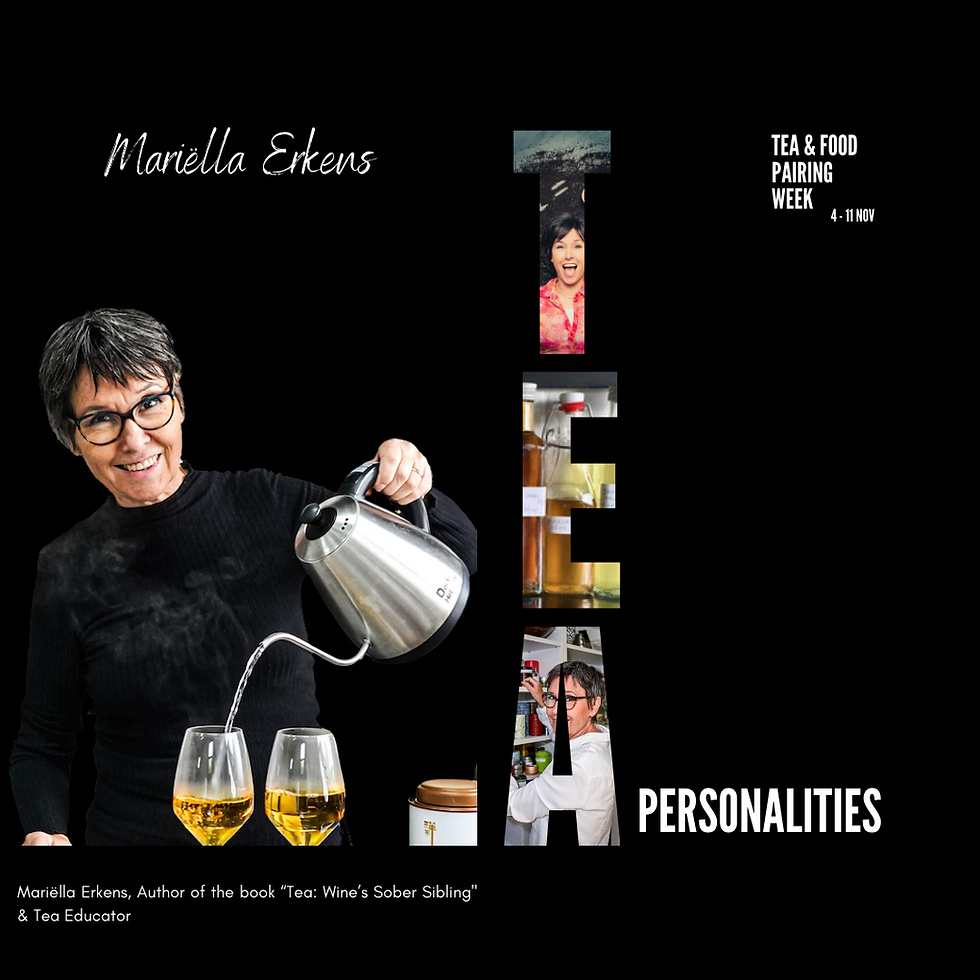Reconstructing Rituals: How Acala Is Reimagining Wine, Cocktails, and Fine Dining Through Sparkling Tea
- Lorela Lohan

- Aug 20
- 6 min read
Updated: Aug 26
Interview with Martynas Žemavičius – Co-Founder of Acala Sparkling Teas
Introduction
While on a recent business and leisure trip to Lithuania, I made a spontaneous request to visit Acala’s production site in Kaunas. It happened to coincide with the 5th anniversary of Acala—a fitting occasion to immerse myself in their craft.
I had the opportunity to taste two of their iconic creations:
White Wine Style: subtle, floral, and gastronomically versatile
Red Wine Style: deeper, more tannic, with aromas reminiscent of a fine red vintage
The visit included a guided tour of the production site, where Martynas (the co-founder) and his team use a meticulous fermentation process. The base begins with fermenting the tea, followed by extended maturation in vessels such as glass demijohns, stainless steel tanks, or even repurposed wine and whisky barrels. The result is a sparkling tea that continues to age in bottles—what Martynas calls a “living product.”
Meet the Co-Founder
Martynas Žemavičius is a sommelier and sensory expert with a distinguished 20-year career in the fine wine and champagne industry in London. He holds a Wine & Spirit Education Trust Diploma and served as a Champagne Judge at the Decanter World Wine Awards, as well as a finalist in the prestigious Champagne Academy program.
Beyond wine, Martynas holds a professional diploma in natural perfumery—an expertise that now fuels his ability to craft complex, gastronomic non-alcoholic beverages that rival traditional wines in aroma and flavour structure.

From Wine to Tea: A Personal and Professional Shift
Lorela: Martynas, you spent two decades immersed in the world of wine, from tastings to global consultancy. What compelled you to pivot from a prestigious career in wine into the NOLO (no/low alcohol) segment—and specifically toward the sparkling tea category? Was it purely personal, or did you perceive a broader market opportunity?
Martynas: The pivot was initially sparked by personal experience, but it quickly revealed a massive market void. When my wife became pregnant, we both stopped drinking alcohol and began evaluating non-alcoholic alternatives. We found ourselves frustrated. Most NA wines were flat, overly sweet, or lacked any form of structure or gastronomic compatibility. I realised there was an unmet need—not just for a better product, but for a better experience.
Our early experiments began with kombucha. As a fermented tea, it gave us an entry point into working with acidity, effervescence, and microbial cultures. But we quickly discovered its limitations. Kombucha was too volatile—often overly acidic—and lacked the elegance or consistency required for fine dining. It had promise, but it wasn’t the final answer.
That’s when we turned to tea itself, treating it not just as an ingredient but as the foundation for a wine-like structure.
Sparkling tea offered a canvas rich in tannins, acidity, and aroma—the essential elements we expect from fine wine. It became a mission: to elevate the non-alcoholic experience, not just replicate it.
The Craft of Complexity: From Wine Glass to Fermentation Jar
Lorela: When you approach a new blend for Acala, do you rely more on instinct and palate memory, or is it a process driven by technical benchmarks like acidity, residual sugar, and polyphenol content? Could you walk us through your creative and scientific process?
Martynas: It’s a hybrid process. We start by defining the emotional goal—should the drink feel bright and playful, or contemplative and aged? From there, we reverse-engineer the structure using wine analogues: we assess pH targets, degrees Brix, tannin load, and volatile aromatic compounds. Then the artistry begins—blending teas, herbs, fruits, and flowers in layers.
We conduct extensive lab testing alongside constant sensory evaluations. Like composing a perfume or designing a wine cuvée, it’s iterative and intuitive.

What Defines a Great Tea for Acala?
Lorela: Tell us more about the sourcing side. With so many tea estates and herb growers globally, how do you navigate quality assurance? Are there regions or producers you favour, and how do you ensure transparency and sustainability in your supply chain?
Martynas: We source globally but think hyper-locally when it comes to each ingredient’s role. We’ve blind-tasted over 300 teas since the beginning of Acala.
Organic certification is a minimum threshold, but taste, aroma, and terroir expression are critical.
We partner with valuable suppliers in Germany and Lithuania. For botanicals, we favour wildcrafted herbs and berries from the Baltic forests. Transparency, traceability, and respect for growers are non-negotiable, even though we do not buy directly from producers.
The Role of Tea in the NOLO Movement
Lorela: Tea has emerged as a frontrunner in the evolving NOLO space, particularly in gastronomy. In your view, what differentiates tea from other non-alcoholic bases like kombucha, verjus, or distilled botanicals?
Martynas:
Tea is the only base that mirrors the complexity of wine.
It offers tannins, complexity, volatiles, and a rich historical context. Kombucha, for example, is often acidic and fizzy but lacks elegance. Distilled botanicals can be aromatic, but they rarely offer texture or evolution. Tea—especially when fermented and blended with freshly brewed infusions and other botanicals—allows us to craft a complete gastronomic journey from nose to finish.
Acala as a "Living" Product
Lorela: You describe Acala as a “living tea.” Beyond the poetry of the phrase, what happens in the bottle over time? Does your sparkling tea have a shelf life or ideal drinking window?
Martynas: Great question. Acala undergoes a three-step filtration process to prevent refermentation, but we deliberately avoid stabilisers or preservatives. This allows the product to evolve naturally. Over time, the volatile esters transform, the acidity softens, and the profile becomes rounder. Our White Wine Style, for example, gains nutty and honeyed notes after two years.
We like to think of it as a vintage beverage, where the year and batch matter.
Sparkling Tea in Fine Dining: From Niche to Norm?
Lorela: Can you share insights into how the fine dining industry is responding to Acala? What barriers have you faced getting sommeliers and chefs to embrace a non-alcoholic product, and what breakthroughs have you seen?
Martynas: There was initial scepticism—understandably. Sommeliers have often been trained to think of non-alcoholic options as compromises. But once they taste Acala, especially with food, the tone shifts. Chefs love it because it complements their creations.
One of the key enablers has been our decision to name blends in ways that evoke familiar wine or cocktail categories—Red Wine Style, White Wine Style, Mimosa Style.

This gives sommeliers a practical tool for pairing and helps guests navigate the experience with confidence. It bridges the gap between curiosity and comfort.
We’re now listed on the menus of three-star Michelin restaurants and luxury hotels. Our presence in Barcelona was a milestone—being listed alongside fine wines in sommelier portfolios.

For Wine Lovers Trying Acala for the First Time
Lorela: Let’s talk about conversion. Which of your blends is best suited to convert a sceptical wine drinker—particularly one who values acidity, structure, and mouthfeel?
Martynas: I’d recommend our Red Wine Style. It’s built with fermented black and pu’er tea, hibiscus, wild blueberry juice, and blackcurrant. It has colour, grip, aromatic lift, and a long, satisfying finish. It resonates particularly well with lovers of Pinot Noir from cooler climates like France or New Zealand. It’s familiar, yet entirely its own.

Ingredient Sourcing Beyond Tea
Lorela: Beyond the tea leaves themselves, what other ingredients do you find indispensable in your blends? Do you experiment with fermentation cultures, native yeasts, or less conventional elements?
Martynas: Absolutely. We use botanicals like hemp tea for mouthfeel, chokeberries for acidity, and local Baltic herbs for complexity. We also experiment with native fermentation cultures to initiate our fermented tea bases. Some batches are aged for over six months in wine and whisky oak barrels to add toasted and sweet spiced notes. It’s a modular system—each element builds a layer in the final narrative.
From Scent to Sip: The Perfumery Parallel
Lorela: You’re a trained perfumer—a rare background for a beverage creator. How does that expertise shape your approach to developing new Acala products?
Martynas:
Perfumery teaches you to think in accords.
You don’t just blend for harmony—you build tension, contrast, progression. For instance, our Red Wine Style begins with a top note (often floral), a heart (usually the tea base), and a base (something earthy or spiced). I treat each blend as a composition.
The Future of Acala and the Industry
Lorela: Finally, what’s your long-term vision for Acala? Are you building a category leader, a cultural movement, or something more?
Martynas: All of the above. Acala isn’t just a product—it’s a philosophy: moderation with meaning. We want to sit on tasting menus next to wine and be treated with equal reverence.
We want to lead the NOLO space not just in quality, but in redefining what elegant drinking looks like.
We aim to inspire a new generation of drinkers who choose with intention—not compromise.
In the long run, we see Acala helping to shape a new category within gastronomy—one that’s not bound by alcohol content, but by craftsmanship and sensory value. Just as natural wines once redefined what purity and terroir could mean, we want sparkling tea to open minds about fermentation, time, and taste.
The goal isn’t to remove alcohol from the table—it’s to add choice, depth, and inclusivity. We want people to drink differently, not less, and for restaurants, sommeliers, and hosts to feel empowered to offer a compelling alternative that stands on its own merits.`

Photo Credits: Acala Sparkling Tea











Comments